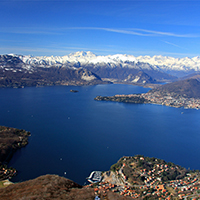Model simulations of the ecological dynamics induced by climate and nutrient load changes for deep subalpine Lake Maggiore (Italy/Switzerland)
Model simulations of the future ecological dynamics of Lake Maggiore

Submitted: 4 February 2020
Accepted: 3 June 2020
Published: 12 June 2020
Accepted: 3 June 2020
Abstract Views: 1878
PDF: 476
Supplementary: 110
HTML: 17
Supplementary: 110
HTML: 17
Publisher's note
All claims expressed in this article are solely those of the authors and do not necessarily represent those of their affiliated organizations, or those of the publisher, the editors and the reviewers. Any product that may be evaluated in this article or claim that may be made by its manufacturer is not guaranteed or endorsed by the publisher.
All claims expressed in this article are solely those of the authors and do not necessarily represent those of their affiliated organizations, or those of the publisher, the editors and the reviewers. Any product that may be evaluated in this article or claim that may be made by its manufacturer is not guaranteed or endorsed by the publisher.
Similar Articles
- Mariana C. Hennemann, Mauricio M. Petrucio, High chlorophyll a concentration in a low nutrient context: discussions in a subtropical lake dominated by Cyanobacteria , Journal of Limnology: Vol. 75 No. 3 (2016)
- . Issa, Festus Aka Tongwa, Alfred G. Mouliom, Dmitri Rouwet, Wilson Y. Fantong, Boris Chako Tchamabé, Takeshi Ohba, Yutaka Yoshida, Daniel Sighomnou, Nkamdjou Sigha, Minoru Kusakabe, δ18O and δD variations in some volcanic lakes on the Cameroon Volcanic Line (West-Africa): generating isotopic baseline data for volcano monitoring and surveillance in Cameroon , Journal of Limnology: Vol. 74 No. 1 (2015)
- Juta Haberman, Marina Haldna, Indices of zooplankton community as valuable tools in assessing the trophic state and water quality of eutrophic lakes: long term study of Lake Võrtsjärv , Journal of Limnology: Vol. 73 No. 2 (2014)
- Renan S. Rezende, Patrícia R.S. Correia, José F. Gonçalves Jr, Anderson M. Santos, Organic matter dynamics in a savanna transition riparian zone: Input of plant reproductive parts increases leaf breakdown process , Journal of Limnology: Vol. 76 No. 3 (2017)
- Gregorio A. López Moreira M., Marco Toffolon, Franz Hölker, Hitting the sweet spot of complexity: Reasons why the development of new custom-tailored models is still warranted and should be encouraged in aquatic sciences , Journal of Limnology: Vol. 80 No. 3 (2021): Celebratory Issue - 80th Anniversary of the Journal of Limnology
- Stephan Hilgert, Friedrich Gauger, Sebastian Hölzlwimmerl, Stephan Fuchs, Development of a flexible dialysis pore water sampler placement system: easy handling and related error sources , Journal of Limnology: Vol. 74 No. 2 (2015)
- Maxine A.D. Mowe, Simon M. Mitrovic, Richard P. Lim, Ambrose Furey, Darren C.J. Yeo, Tropical cyanobacterial blooms: a review of prevalence, problem taxa, toxins and influencing environmental factors , Journal of Limnology: Vol. 74 No. 2 (2015)
- Jordi Catalan, John C. Donato Rondón, Perspectives for an integrated understanding of tropical and temperate high-mountain lakes , Journal of Limnology: Vol. 75 No. s1 (2016): Proceedings of the 6th National Congress of Limnology
- Claude Lang, Phosphorus decreases in Lake Geneva but climate warming hampers the recovery of pristine oligochaete communities whereas chironomids are less affected , Journal of Limnology: Vol. 75 No. 2 (2016)
- Xing Wang, Binghui Zheng, Lusan Liu, Lijing Wang, Development and evaluation of the Lake Multi-biotic Integrity Index for Dongting Lake, China , Journal of Limnology: Vol. 74 No. 3 (2015)
<< < 2 3 4 5 6 7 8 9 10 11 > >>
You may also start an advanced similarity search for this article.

 https://doi.org/10.4081/jlimnol.2020.1963
https://doi.org/10.4081/jlimnol.2020.1963





